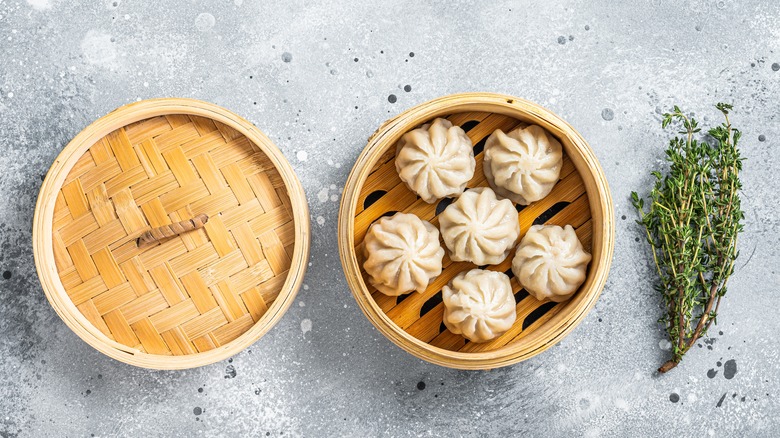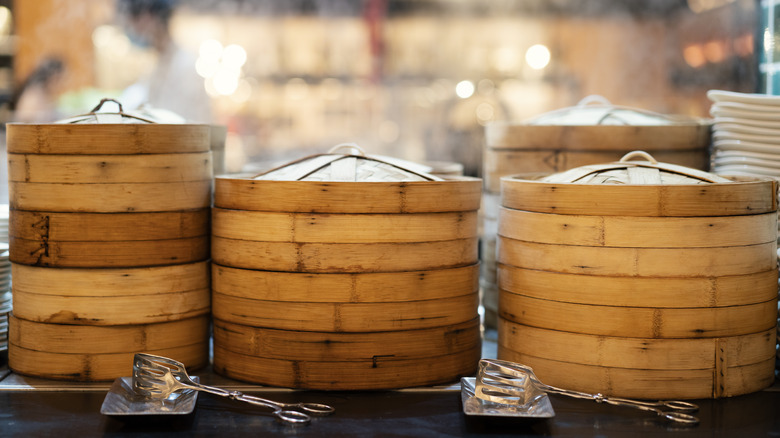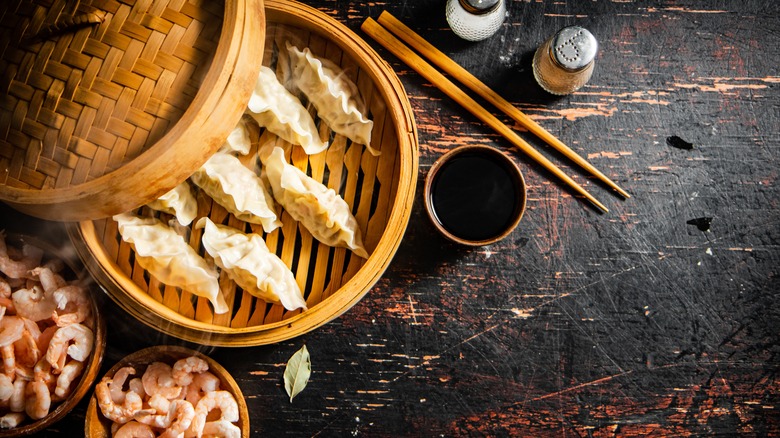How Does A Bamboo Steamer Basket Work?
Bamboo steamers are an inexpensive and incredibly effective tool to get perfectly steamed food at home. But if you're unfamiliar with the bamboo steamer, you may be a bit daunted at first glance — but then ultimately surprised to find out just how crazy easy they are to use. Simply put, they work by setting the bamboo steamer inside an open pot of simmering water. Doing this allows the steamer to trap the steam and cook your food thoroughly with the power of indirect, steamy heat. You can get these steamers pretty easily and cheaply, as they're available at most Asian grocery stores and typically cost as little as 20 dollars.
The steamer basket is made to sit inside a wok (or similarly-sized pan) filled with simmering water. The trick to it — and it's not much of a trick — is to make sure that the water touches the bottom rim of the steamer basket without bubbling up inside the compartment holding the food. The bottoms of steamer baskets are filled with holes or slats to allow in steam, which, when held in by a lid, will either cook or reheat. The reason for this steamer basket placement is twofold: First, you want to steam your food, not boil it; and second, having the water in contact with the base of the steamer basket prevents scorching.
Tips for using a bamboo steamer
From fish to all the many different types of dumplings, bamboo steamers will cook just about anything. One of their best features is that they're stackable, so you could conceivably use them to prepare an entire multi-course meal. The steam is able to reach each tier of the stacked bamboo trays as you maintain a steady simmer. Remember that timing is everything when steaming, so it's best to identify steam times for whatever it is you're making. For instance, steaming meats will always take longer than steaming frozen dumplings, and you'll want to ensure you have an estimated steam time in mind before you get started.
Be sure that when you're steaming the water level in your chosen pot isn't too high — one inch of water is recommended. You also want space around the sides of the steamer, so choose a pan that's larger in diameter than your basket(s). Be mindful of how hard the water is boiling as well, and keep an eye on the water level. If you boil your water rather than simmer it, you may run the risk of over-steaming and total evaporation of the water (which will have the opposite outcome of both scorching your pot and undercooking the food in your steamer).
Preparation and maintenance
Keeping your bamboo steamer clean is another crucial part of using it to ensure it keeps working for you. When you're steaming foods that are starchy or may stick to the steamer, consider lining the bottom of the tray with parchment paper or even cabbage leaves — making sure to poke holes in the parchment or leaves so that the steam can get to the food. Never put your bamboo in the dishwasher, it will destroy it — and there's really no salvaging once it's happened. Instead, simply clean the steamer shortly after use with hot, soapy water. But don't let the steamer soak in soapy water, as the bamboo will absorb it and it can impart soapy flavors to your food.
So, what kind of food can you cook in a bamboo steamer? Well, besides the aforementioned dumplings and fish, these very versatile steamers can be filled with rice, char siu bao (dim sum pork buns), eggs, vegetables of all sorts (from broccoli to Swiss chard), Vietnamese bánh cam glutinous rice balls, Indian idli rice cakes, Mexican tamales, and British sticky toffee pudding — to barely scratch the surface. Get steaming!


